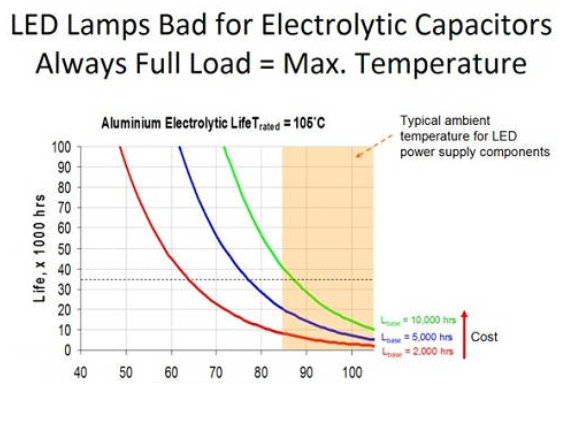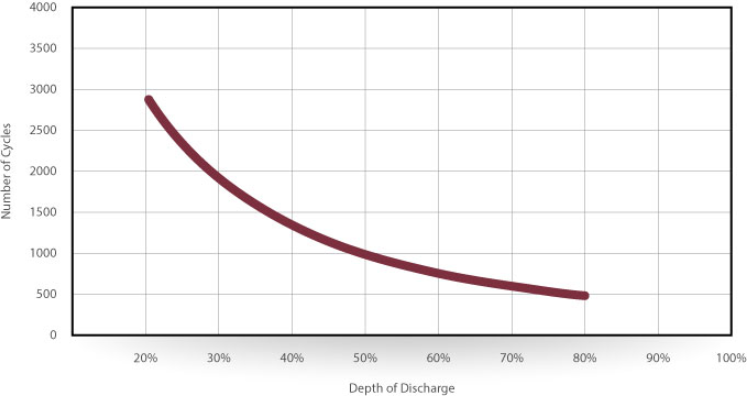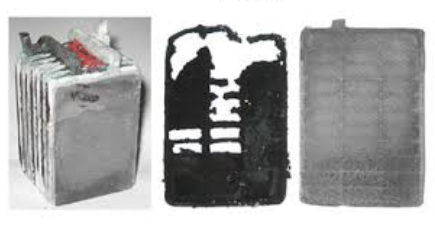-
1Temperature aging process
I think the most critical components that are aging the capacitors (especially the electrolytic ones) and the rechargeable batteries. The picture below, shows a life expectancy characteristic of some average aluminium electrolytic caps.
Now the question is not how long before the capacitors loose most of their capacity or they go completely bad. In some cases, I saw capacitors that are loosing only 10% of their actual capacity or they are increasing their ESR with just a couple of OHMs and this causes a ripple voltage on the MCU that is greater than 300mV or 500mV and this is enough to cause the MCU to restart. This is the cause in all the cases of bad capacitors in monitors or other devices. A rule of the thumb would be to estimate that in normal condition, the capacitors are usually designed to last about ten yeas. If you expose the capacitors to a temperature that exceeds 25 Celsius degree with 15 to 20 degrees, the lifetime of the component shortens in half.
Of course now, the design could be more robust. For instance, If I'm designing a thing that I want to last in harsh conditions for 15 years instead of the usual 5, the thing to do is to forget about linear power supplies and to go for some Bust-Buck converters that will function at 100-150KHz and hopefully, a simple 100uF capacitor will be more than enough even after 10 years when there is nothing much left of it.
In what comes the lifetime of a regular Li-ion battery, or an AGM battery, the expectancy given by the manufacturer depends on the number of discharges and how deep you discharge it.
The manufacturers say that if you don't discharge your batteries more than 25% of their capacity, they could last for about 2000 cycles. If you have some batteries for a solar system or for a portable device and you charge them once a day, technically, you can go up to 5-6 years of usage. Now it depends on the battery and some manufacturers give better performances than others. They do say though, that the lifetime of the battery shortens in half if you expose the battery to a temperature that is 10 degrees over the nominal 25C. This means that with a bit of luck, in normal operation, some normal batteries are destined to last for just about 3 years.
For these components, some chemical processes are involved and these processes are accelerated in most cases at higher temperatures. Both type of components have metallic plates and an electrolyte between them and this means that electrons and ions are moving from one plate to another. This material migration it is always happening unevenly because the materials are not perfectly homogeneous, they have impurities and they are not having perfect geometry or perfectly smooth surfaces at atomic level. The most expensive ones, are expensive because they use quality materials and better manufacturing processes. This is why in the chart above, the green line representing the better quality capacitors has a better life expectancy. In the case of the AGM batteries, because of the repeated migration of the materials back and forth between the plates, they end up having different structures or different geometries. They grow dendrites that short circuits the plates and eventually they will end up even having entire plates being depopulated of the necessary materials. We perceive this as a capacity lost when we test the battery.
Temperature is also influencing the life of the PCB and it can favor the semiconductor diffusion effect. This can lead to burned or broken PCB traces, broken viases and burned components like in the video below:
 Marius Taciuc
Marius Taciuc


Discussions
Become a Hackaday.io Member
Create an account to leave a comment. Already have an account? Log In.
You really should crop off the LED lamp part of that graph as I was expecting to see talk about LED.
> If you expose the capacitors to a temperature that exceeds 25 Celsius degree with 15 to 20 degrees, the lifetime of the component shortens in half.
Capacitor lifetime parameter are usually given at their maximum rated temperature in their datasheet - NOT 25C.
> Bust-Buck converters
Spelling mistake.
>go for some Bust-Buck converters that will function at 100-150KHz and hopefully, a simple 100uF capacitor will be more than enough even after 10 years
It won't be a ''simple'' 100uF cap any more as you have to design with the right type of capacitor. A switch mode supply has ripple current that can cause self heating effects in the capacitor which you haven't taken into account. 100uF may or may not be high enough at 100 -150kHz depending on capacitor type and what type of load.
Are you sure? yes | no